 Oakland Chinatown, USA Oakland Chinatown, USA
Chinese came to Oakland in significant numbers in the 1850s, after gold was discovered near Sacramento in 1848. They were primarily from southeastern China near Hong Kong. Chinese started congregating in San Francisco and Oakland after being driven from the gold fields by bigotry and violence.
The first Chinese settlements in Oakland were at First and Castro Streets, Telegraph Avenue between 16th and 17th Streets, and San Pablo Avenue between 19th and 20th Streets. These settlements were frequently under siege. One burned down mysteriously. City leaders forced two other Chinese settlements to relocate. By the 1870s, Chinese began setting down roots at 8th and Webster Streets, the epicenter of today’s Chinatown.
More Chinese settled in San Francisco, but Oakland became a viable alternative because of jobs, fertile land, good climate, and easy proximity to San Francisco. Chinese Oaklanders of this era mostly took low-paying jobs. They built Temescal Dam and Lake Chabot Dam. They worked in canneries, cotton mills, and explosives factories. They were cooks, gardeners, houseboys, and laundrymen. They made cigars, helped develop the shrimp and fisheries industries, and labored in the city's thriving railroad building industry. They grew vegetables and fruits, introducing farming innovations and experimenting with new crops like asparagus. Traveling throughout the East Bay region, Chinese peddled fresh fruits and vegetables from baskets hung from a long pole and later in trucks.
Oakland Chinese often faced hostility. Local politicians passed anti-Chinese legislation of one sort or another. Virulent anti-Chinese sentiments broke out throughout California, including Oakland, in the early 1870s, as the general economy soured. The California-grown anti-Chinese movement moved to Washington, D.C., where Congress passed the Chinese Exclusion Act in 1882, barring Chinese laborers. The Chinese population in Oakland and elsewhere dropped sharply, but the 8th and Webster Chinatown survived.
The 1906 San Francisco earthquake and fire provided an unexpected boost to Oakland's Chinatown. Thousands of San Francisco Chinese who fled to Oakland chose to stay in Oakland. Some white Oaklanders, however, pressured the city to restrict the growing Chinese population to the 8th and Webster neighborhood. Chinatown grew nonetheless, from the waterfront up to 10th Street along the Webster corridor.
Even as Chinatown grew, it became more isolated. But the Chinese developed a complex society. They organized men and women's sports teams. The Wa Sung Service Club began as a baseball team in the 1920s. Chinese organizations emerged and evolved – family and district associations, business associations, tongs, and civil-rights groups. Some tongs engaged in criminal activities like the Chinese lottery. Patriotic organizations had strong ties to Chinatown. One was the Kuomintang, the political movement founded by Sun Yat-Sen, leader of the Chinese Republic. Another was the Chinese American Citizens Alliance (CACA), which fought for the civil rights and assimilation of Chinese Americans. The Oakland lodge at 8th and Harrison Streets was the third CACA branch formed.
Oakland Chinese remained largely segregated in the first half of the 20th century. But as family life gradually developed in Chinatown, a process of Americanization began, and Lincoln Elementary School was a principal vehicle of acculturation. Chinatown children also went to Chinese schools. By the early 1930s, there were as many as a dozen such schools in Chinatown. In 1953, the Oakland Chinese Community Center with a Chinese school opened at 9th and Harrison Streets to great fanfare. Protestant Christian churches have been influential in Chinatown. Chinese Presbyterian, Methodist, Episcopal and Baptist churches continue to have followings in Chinatown today.
A second cataclysmic event -- World War II -- accounted for Chinatown's greater integration in Oakland and the creation of a new Chinese American middle class. Congress repealed the Chinese Exclusion Act in 1943, reflecting China's status as a U.S. ally in World War II. Shipyards hummed in Oakland, employing many people, including Chinese. Chinatown businesses benefited. The Oakland Chinese population grew 37.5 percent to 5,500 in the 1940s. Some Oakland Chinese fought in the war, while others raised funds to help China battle the invading Japanese. (See China Relief Fund) This duality has been a continuing undercurrent for older generations of Chinese Americans.
For the smaller number of Japanese Americans around Chinatown, however, World War II wasn’t a good time. They were shipped off to internment camps in remote areas of the west. The Japanese presence in Oakland has never been quite the same. Filipinos also found work in Chinatown in the 1930s and 1940s.
In the post-war years, the younger generation Chinese Americans began getting work and buying homes in other parts of Oakland that once forbade Asians. Ironically, the World War II prosperity was short-lived for Chinatown. With the shipyards shut down and its younger generation moving out, Chinatown suffered. Major public projects -- the Nimitz Freeway, the Bay Area Rapid Transit District, Laney College, and the Oakland Museum – gobbled up Chinatown housing. The insulated vibrancy of Chinatown, evident in the decades before and during the war, became muted in the 1950s.
Chinatown's dormant state lasted well into the 1960s, until Congress liberalized laws allowing more immigration from Asia (and Latin America). Oakland Chinatown experienced a renaissance, beginning in the 1970s. The renaissance was accelerated when the end of the Vietnam War brought over thousands of refugees from Southeast Asia, some of them ethnic Chinese.
Oakland's Chinatown showed new life. Shuttered storefronts became restaurants and shops. Gasoline stations transformed into multi-use buildings. Property values soared. More banks opened Chinatown branches. Redevelopment, a dream of Chinatown leaders since the somnambulant 1950s, resulted in the multi-purpose Pacific Renaissance Plaza on 9th Street, Franklin and Webster Streets. This project attracted Hong Kong money, as have other smaller developments.
This growth brought greater ethnic diversity to Chinatown and a continuing cycle of immigration adaptation issues. The Chinese were the first Asian presence in Oakland, followed by Japanese, Filipinos and Koreans. After 1965, the community exploded with immigrants and refugees from all over Asia. Traditional Chinatown’s resurgence and the creation of a new Asian district east of Lake Merritt are attributable in part to a Southeast Asian influx.
Perhaps Chinatown is now a misnomer because the traditional Asian district at 8th and Webster, while still very Chinese, is much more than that today. The ebb and flow of the Asian communities in Oakland have been and will continue to be influenced by immigration policies and geopolitical and globalization trends. With multiple generations of Chinese, and other Asians living all over the city and a population of at least 60,000, the Chinese American and Asian American presence in Oakland is now deeply rooted.
Article contributed by Mr. William Wong.
First publish on his website
http://www.oaklandchinatownhistory.org/chinatown.html
Related articles:

|
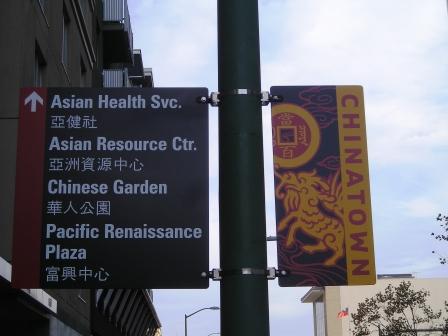
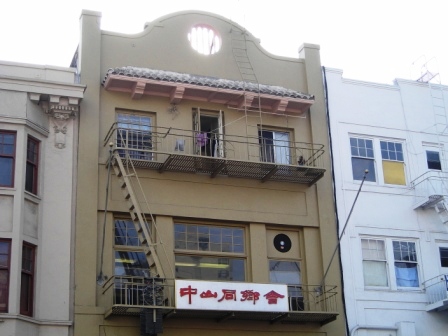
Clan Association
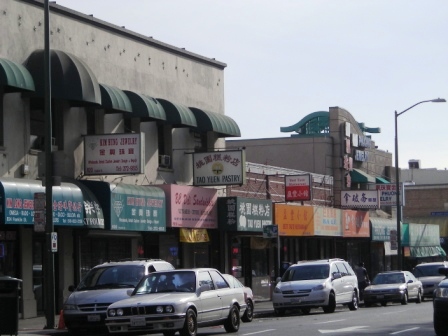
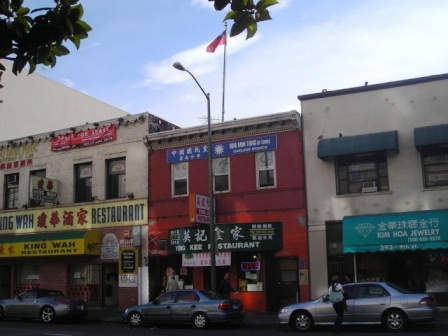
Oakland branch of kuo Min Tang (KMT) office

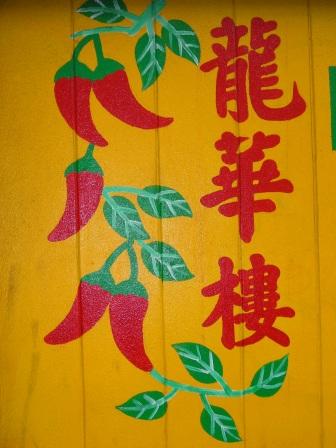
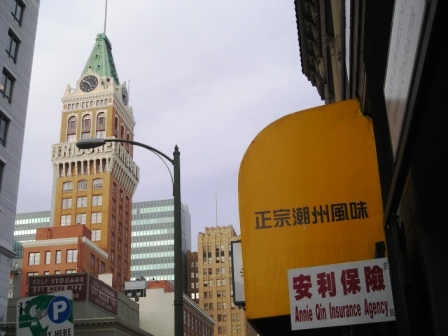

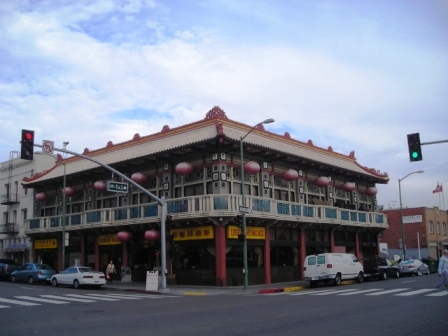

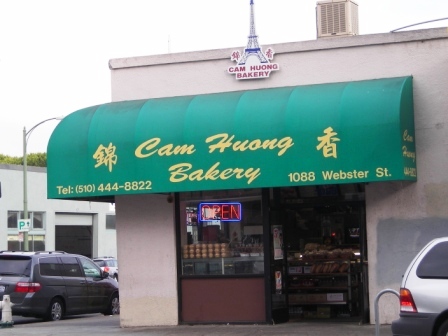
|

 Oakland Chinatown, USA
Oakland Chinatown, USA










